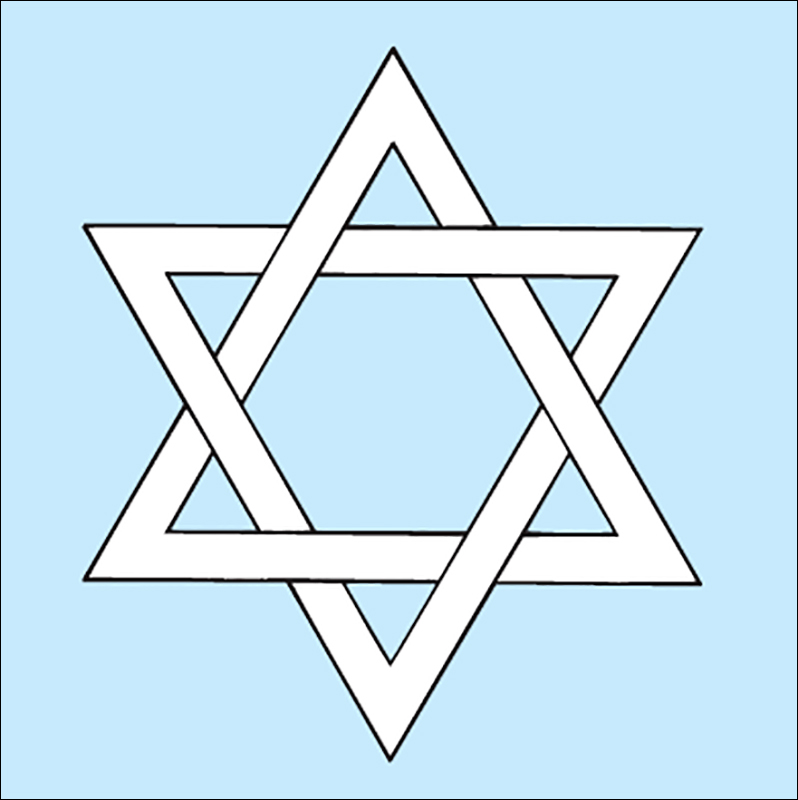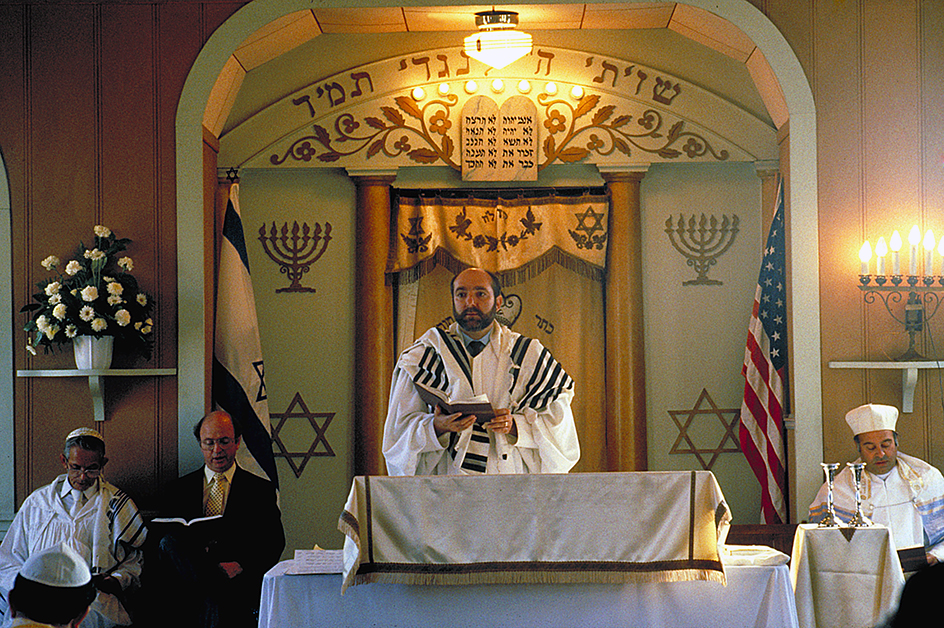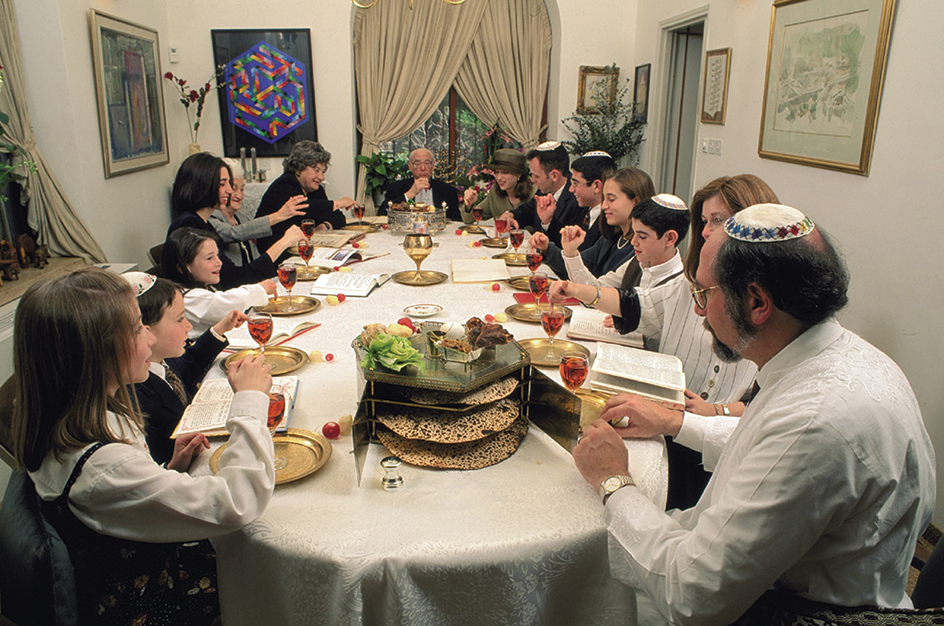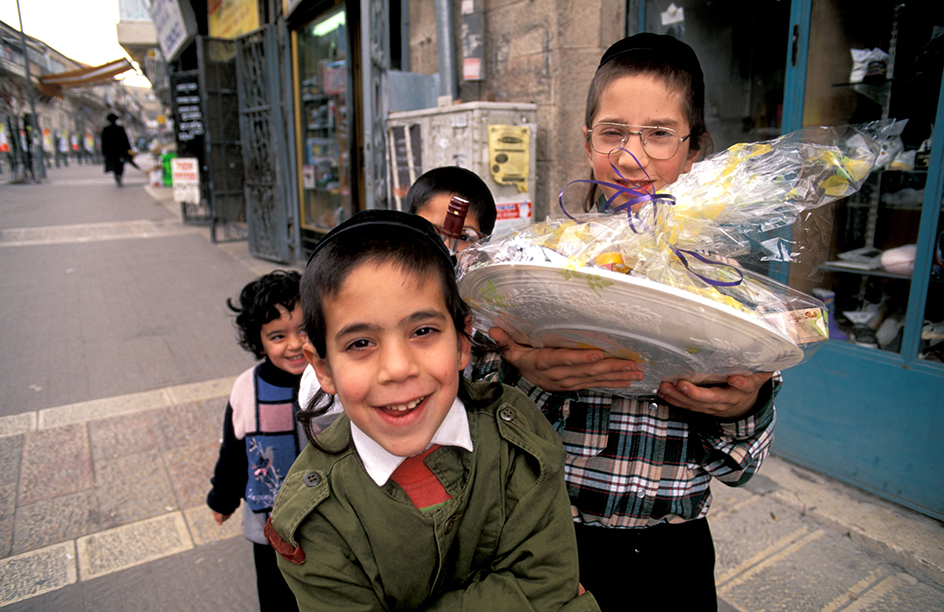Judaism, << JOO dee ihz uhm, >> is the religion of the world’s approximately 15 million Jews. It is one of the oldest major religions and the first religion to teach the belief in one God. Unlike the other major religions, Judaism is the religion of only one people—the Jews. Both Christianity and Islam developed from Judaism. These religions accept the Jewish belief in one God and the moral teachings of the Hebrew Bible. The Hebrew Bible is also called the Old Testament by Christians. The basic laws and teachings of Judaism come from the Torah, the first five books of the Hebrew Bible.

This article discusses the teachings; sacred writings; branches; structure; holy days and festivals; and customs and ceremonies of Judaism. For information about the history of the Jewish people, see Jews.
The teachings of Judaism
The most important teaching of Judaism is that there is one God, the creator of heaven and earth, who wants people to do what is just and merciful. Judaism teaches that a Jew serves God by studying the Scriptures and fulfilling the divine commandments that they contain. Jewish scriptural teachings include both ritual practices and ethical laws. Judaism teaches that all people are created in the image of God and deserve to be treated with dignity and respect. Thus, moral and ethical teachings are as central to Judaism as its teachings about God.
The covenant with God
is a special agreement that Jews believe God made with Abraham, the ancestor of the Jewish people. According to the Bible, God promised to bless Abraham and his descendants if they worshiped and remained faithful to God. God renewed this covenant with Abraham’s son Isaac and Isaac’s son Jacob. Jacob was also called Israel, and so his descendants became known as the children of Israel or the Israelites. God later gave the Israelites the Ten Commandments and other laws through their leader Moses. These laws explained how the Israelites should live their lives and build their community.
The Jews are sometimes called the Chosen People, meaning that God chose them from all the nations to have a special relationship with him, as descendants of Abraham, Isaac, and Jacob. For this reason, they have special duties and responsibilities commanded by God. For example, the Jews must establish a just society and serve only God. The covenant assures the Jews of God’s love and protection if they follow his laws. There are a total of 613 commandments. The covenant also makes Jews accountable for their sins and shortcomings.
The Messiah.
Traditionally, Jews believed that God would send a Messiah to save them and reconcile people with God. The Messiah will restore the land of Israel, defeat the enemies of the Jews, and bring peace and justice to the world. The word Messiah comes from the Hebrew word mashiah, which means the anointed one. The Book of Isaiah describes the Messiah as a just ruler who will unite the Jewish people and lead them in God’s way.
Many Jews still expect a Messiah to come. Others speak instead of a Messianic age. They believe a period of justice and peace will come about through the cooperation of all people, with the help of God. Some Jews believe that a Messiah will come only if there is already peace in the world, while others believe the Messiah will bring peace. Many Jews think that following the laws of the Torah and improving the world for all peoples will hasten the Messiah’s arrival.
The sacred writings of Judaism
Judaism has two major collections of sacred writings, the Hebrew Bible and the Talmud. These works provide the basis for Judaism’s beliefs and practices.
The Hebrew Bible.
The first five books of the Hebrew Bible make up the Torah, the most important of all Jewish Scriptures. The Torah is also called the Pentateuch, meaning five books. The Torah contains basic Judaic law and describes the history of the Jews until the death of Moses in the 1200’s B.C. According to Jewish tradition, Moses received and wrote down the word of God in the Torah, which is sometimes called the Five Books of Moses. Many modern scholars, however, believe that different parts of the Torah were passed down in several collections, which were later edited into the five books we have today. In addition to the Torah, the Hebrew Bible contains books of history and moral teachings called the Prophets and 11 other books called the Writings.
The Talmud
is a collection of legal, ritual, and ethical writings, as well as Jewish history and folklore. It serves primarily as a guide to the civil and religious laws of Judaism. Orthodox Jews believe the laws in the Talmud were an “oral Torah” that God gave Moses to explain the written Torah. About A.D. 70, scholars began to write down these oral laws. Rabbi Judah ha-Nassi collected these laws around A.D. 200 in a work called the Mishnah. From about 200 to 500, scholars interpreted the Mishnah. Their comments were later recorded in what is now called the Gemara. The Mishnah and the Gemara together make up the Talmud.
The branches of Judaism
Modern culture has posed challenges to traditional Jewish observance and faith. Jews have made a variety of responses to these challenges that have resulted in the division into several branches of Judaism. In the United States and Canada, the four main branches are (1) Orthodox Judaism, (2) Reform Judaism, (3) Conservative Judaism, and (4) Reconstructionist Judaism. Each represents a wide range of beliefs and practices.
Orthodox Judaism
continues traditional Jewish beliefs and ways of life. In general, Orthodox Jews believe that God revealed the laws of the Torah and the Talmud directly to Moses on Mount Sinai. They strictly observe all traditional Jewish laws, including dietary rules and laws for keeping the Sabbath. Orthodox Jews pray three times daily—in the morning, in late afternoon, and after sunset. The men wear hats or skullcaps called yarmulkas or kipot at all times as a sign of respect to God. Many married Orthodox women cover their hair.
A kind of Orthodox Judaism known as Modern Orthodoxy attempts to combine the traditional way of life with participation in the general culture. Hasidic Orthodox Jews, in contrast, wear traditional Eastern European Jewish clothing and stress the joy of worshiping God and performing his commandments.
Reform Judaism
began in Germany in the early 1800’s, when some Jews questioned traditional teachings about the source of Judaism’s sacred writings. For example, they considered the laws in the Talmud to be of human rather than divine creation. These people claimed that Judaism was defined chiefly by the Bible.
Reform Jews focus on the teachings of the Hebrew prophets with their message of ethics. Many reform Jews feel that Jewish rituals are not obligations but instead can be subject to human judgment. Many Reform Jews stress the authority of each Jew and Jewish community in deciding which traditional practices to continue or discard.
Conservative Judaism
developed during the late 1800’s. Conservative Jews maintain the authority of the Bible and the Talmud, but they also believe that Jewish practice may change to fit the times. The Conservative movement requires observance of most traditional Jewish laws and customs. Conservative Jews believe that rabbis may alter some Jewish laws, but they also believe that such changes must be based on a precedent—that is, an earlier legal decision that serves as a guide.
Reconstructionist Judaism
grew out of Conservative Judaism during the early 1900’s in the United States. It is based on the principle that Judaism is a civilization and its laws and customs are folkways like those of any other society. Reconstructionist Judaism holds that rituals and customs should develop according to a community’s needs and desires. It openly rejects the teaching that God chose the Jewish people exclusively.
The structure of Judaism
Judaism has no one person as its head and no international body with authority over religious practices. Each local congregation chooses its own rabbi and manages its own affairs. In addition, each branch of Judaism has one or more seminaries for training its rabbis, as well as a body of rabbis that determines common practice.
The synagogue
is the Jewish house of worship and the center of Jewish education and community activities. It has a sanctuary where religious services are held and may include a school where children study Judaism, the Hebrew language, and Jewish history. Most synagogues have a social hall, and some have athletic facilities, lecture halls, swimming pools, and cultural centers. Reform and Conservative synagogues often are called temples.
Most synagogues are constructed so that worshipers face toward the holy city of Jerusalem during services. At the front of the sanctuary stands the ark, a chest that holds the scrolls of the Torah. Above or in front of the ark hangs the eternal light, an electric or oil lamp whose constant flame symbolizes God’s eternal presence.
The rabbi
serves as a spiritual leader, teacher, and interpreter of Jewish law. Traditionally, rabbis were chiefly teachers of the law. Today, rabbis also deliver sermons, counsel people, and perform other functions. A person who wants to become a rabbi must spend years studying Hebrew, Jewish history and sacred writings, philosophy, and law. Most rabbinical students also study a wide range of nonreligious subjects. Except in Orthodox Judaism, women as well as men may become rabbis.
The cantor
chants the prayers during worship in the synagogue. The cantor is often a professional who has a trained voice and special knowledge of Hebrew and the traditions of chanting. The cantor also may direct a choir and conduct religious education.
Worship
in Judaism takes place in the home and the synagogue. Important parts of home worship include daily prayers, the lighting of the Sabbath candles, and the blessing of the wine and bread at the Sabbath meal. Jews also observe many holiday rituals at home.
Worship practices in the synagogue differ among, and even within, the branches of Judaism. Orthodox and Conservative synagogues conduct services daily, but most Reform synagogues have services only on the Sabbath and holidays. In all Orthodox and some Conservative synagogues, at least 10 men must be present for a service to take place. This minimum number of participants is called a minyan. Any male who is at least 13 years old may lead the service. In most Conservative, Reform, and Reconstructionist congregations, women may lead the service and be part of the minyan.
Synagogue worship consists mainly of readings from the Torah and the chanting of prayers from a prayer book called the siddur. A different part of the Torah is read each week, so the entire Torah is completed every one to three years, depending on the congregation. In Orthodox synagogues, men and women are separated by a physical barrier called a mehiza. They chant most of the prayers in Hebrew. In Conservative, Reform, and Reconstructionist congregations, men and women sit together, and at least some of the service is in the local language. Most Sabbath and holiday services include a sermon.
Holy days and festivals
The Sabbath.
The seventh day of the week, Saturday, is a holy day of rest for Jews. It begins at sundown on Friday and ends about one hour after sunset on Saturday, at the time when it is calculated that three stars are visible in the evening sky. On the Sabbath, Jews attend worship services in the synagogue and eat special meals at home. Orthodox and some Conservative Jews do not work, travel, or carry money on the Sabbath.
The High Holidays,

Rosh Ha-Shanah , the Jewish New Year, begins on the first day of Tishri and lasts two days. It celebrates the creation of the world and God’s rule over it. According to Jewish tradition, people are judged on Rosh Ha-Shanah for their deeds of the past year. The chief symbol is the shofar, a ram’s horn that is sounded during the holiday worship.
Rosh Ha-Shanah begins the Ten Days of Penitence, which end on Yom Kippur , the Day of Atonement. On Yom Kippur, Jews fast and express their regret for bad deeds during the past year and their hope to perform good deeds in the coming year. Jews observe the holiday mainly through synagogue worship.
The pilgrimage festivals.

Passover, or Pesah, comes in March or April. It marks the Jews’ exodus from Egypt. Jews observe Passover at home at a ceremonial feast called the Seder. During the week of Passover, Jews eat unleavened bread known as matzo (also spelled matzah). Shavuot, or Pentecost, comes 50 days after Passover begins and marks the giving of the Torah to the Jews on Mount Sinai. Many Reform congregations celebrate Shavuot by holding confirmation ceremonies as well. Sukkot is a harvest festival that begins five days after Yom Kippur. Jews build small huts for Sukkot as a reminder of the huts the Israelites lived in during their wandering in the wilderness. On the last day of Sukkot, called Simhat Torah, Jews celebrate the completion of the yearly reading of the Torah.
Other holidays

Customs and ceremonies
Dietary laws.
The Bible, chiefly in the books of Leviticus and Deuteronomy, commands that Jews follow certain dietary rules. Jews who observe these rules do not eat pork or shellfish, such as shrimp or oysters. They store meat and milk products separately and do not serve them at the same meal. They also refrain from eating milk products for several hours after consuming meat. Jews may eat only meat that comes from a healthy animal killed by ritual slaughter called shehitah. Shehitah is designed to kill animals quickly and with minimal pain. It must be done by a specially trained slaughterer, who says a blessing before killing the animal.
Food prepared in accordance with Jewish dietary laws is called kosher, which means ritually correct. Orthodox Jews consider these laws divine commandments and observe them strictly. Many other Jews observe the rules as a sign of their faith or simply as a means of maintaining their Jewish identity.
Special occasions.
When a boy from a Jewish family is 8 days old, he undergoes a traditional surgery called circumcision (removing the skin that covers the head of the penis) as a symbol of God’s covenant with Abraham. Some Jews have developed a ceremony for baby girls called a Simhat Bat, at which family members and friends celebrate the birth. At the age of 13, a boy becomes a full member of the Jewish community. This event is celebrated in the synagogue with a ceremony called a bar mitzvah. Most Reform, Conservative, and Reconstructionist synagogues, as well as some Modern Orthodox synagogues, have a similar ceremony for girls called a bat mitzvah or bas mitzvah. The young person reads from the Torah during the ceremony, which is followed by a social celebration. In Conservative and Reform Judaism, many older teenagers have a ceremony called a confirmation, during which they commit to Judaism.
A traditional Jewish marriage ceremony takes place under a huppa, a canopy that symbolizes the union of the bride and groom. If a marriage breaks up, the husband must give the wife a writ of divorce called a get.
Jews also observe special rituals in connection with death. Burial takes place as soon as possible, usually within a day after a death. After the funeral, the family enters a seven-day period of deep mourning called shiva. The 30-day period following burial includes a return to normal activities after shiva is completed. It leads into an 11-month period of mourning during which the mourners recite a prayer called the Kaddish. The Kaddish praises God but does not mention death. It is recited only during public prayer, in the presence of a minyan. The unveiling of the tombstone, about 11 months after the death, marks the end of the formal mourning period. On each anniversary of the death, the relatives observe a memorial called a yahrzeit, reciting the Kaddish and lighting a candle in memory of the deceased.
